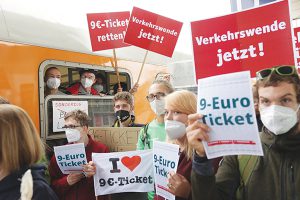Like everybody I know in Germany, I bought the so-called 9-euro ticket this summer. Three, in fact — one each for June, July and August. I put the QR codes in my cell phone’s digital wallet, and was free to hop on and off all buses, trams, local and regional trains nationwide. In a country that specializes in making things complicated, getting around was suddenly simple.
This all-you-can-ride ticket — for about $9 — was a huge experiment that deserves a look from other countries groping for policies against climate change. The impetus was this year’s surge in inflation and, in particular, the energy shock. In response, the German government passed a raft of measures meant to soften the blow to people’s finances. The 9-euro ticket was one.
The most popular one, in fact. The deal expired last week, and everybody’s already talking about how and when to bring it back. So the question — for Germany and other countries — is whether and under what circumstances it’s a good idea to subsidize public transport enough to make it extremely cheap or even free.
The numbers are intriguing. People bought some 52 million 9-euro tickets, and another 10 million who had previously bought an annual subscription got them automatically. I almost wonder about the Germans who didn’t avail themselves of the offer. Presumably, they include babies and people living in deep forests with no bus stops.
If early estimates prove correct, moreover, about 10% of buyers used the ticket to drop at least one of their daily car trips. This saved them a packet in gasoline expenses. It also kept big clouds of carbon dioxide out of the atmosphere — about 1.8 million metric tons. That — after just three months — is equivalent to the emissions from powering 350,000 homes for one whole year, or the savings that can be expected in one year if Germany introduces a speed limit on its autobahns.
This comes as a shock. Cities from Santiago, Chile, to Salt Lake City, Utah, and Tallinn, Estonia, have also experimented with making public transport free. So has the entire small nation of Luxembourg. But they all found that their subsidies didn’t noticeably reduce car trips — either because the people who took more trams, buses and trains were too poor to own cars and would otherwise have walked or cycled; or because public transport was still too inconvenient relative to driving for price to make much difference.
—Bloomberg
 The Gulf Time Newspaper One of the finest business newspapers in the UAE brought to you by our professional writers and editors.
The Gulf Time Newspaper One of the finest business newspapers in the UAE brought to you by our professional writers and editors.
